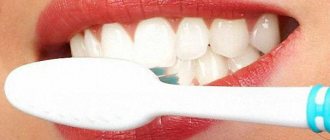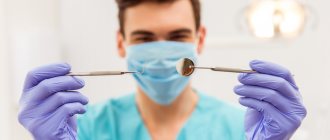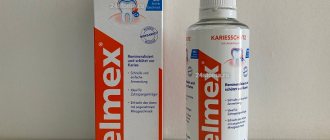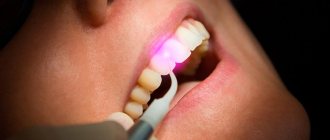A real cocktail
The fluid that is secreted by the salivary glands is a whole cocktail of proteins, vitamins, micro- and macroelements, although most of it, 98–99%, is water.
The concentration of iodine, calcium, potassium, strontium in saliva is many times higher than in the blood. Microelements are also present in the salivary fluid: iron, copper, manganese, nickel, lithium, aluminum, sodium, calcium, manganese, zinc, potassium, chromium, silver, bismuth, lead. Article on the topic Protect the liver. Hepatitis C can be detected by saliva testing
Such a rich composition ensures the proper functioning of salivary enzymes, which begin digesting food in the mouth. One of the enzymes, lysozyme, has a significant bactericidal effect - and it is isolated for the preparation of certain drugs.
Saliva analysis
Author
Kauter Olga Leonidovna
Leading doctor
Therapist
until September 30
We're giving away RUR 1,000 for all services per visit in September More details All promotions
Saliva plays an important role in maintaining the health of the soft and hard tissues of the oral cavity. The functions of saliva include maintaining a neutral pH in the mouth, cleaning and remineralizing teeth, facilitating swallowing and digestion, and protecting oral tissues from drying out and invading microorganisms. Adequate saliva is essential to maintain oral health, and decreased secretion can contribute to problems such as tooth decay, mucositis, oral fungal infections, and periodontal disease.
Saliva has great potential as a diagnostic fluid. It can be used as a biological material for monitoring the general condition of the body, early diagnosis of diseases, and monitoring the progress of treatment. The main advantage of using saliva for these purposes is the simplicity and non-invasiveness of collection. The need to donate blood can sometimes be a psychological problem, since not everyone tolerates this manipulation well and much depends on the skill of the nurse. In the case of saliva, no such psychological threshold arises. Other advantages: smaller aliquots of the sample are needed for saliva analysis, the collected material is easy to store and transport, and saliva test results correlate well with blood counts.
What we call saliva is a mixture of secretions of the major and minor salivary glands, secretions of the mucous membrane, gingival fissure fluid, serum and blood derivatives from oral wounds, desquamated epithelial cells, expectorated bronchial and nasal secretions, bacteria and bacterial products, viruses and fungi, other cellular components and food debris. It is a complex fluid containing a full range of hormones, proteins, enzymes, antibodies, antimicrobial components and cytokines. These components penetrate into saliva from the blood, which is why in many cases it is possible to use salivary biomarkers instead of blood biomarkers.
Saliva is primarily used in the diagnosis of systemic diseases. Modern technologies have enabled the identification of a large number of medically valuable salivary biomarkers for a variety of disease conditions, including cancer, autoimmune, viral, bacterial, cardiovascular, and metabolic diseases. Saliva is actively used as a biomaterial for PCR diagnostics of infections, as well as for assessing the concentration of various hormones.
Sign up for diagnostics Do not self-medicate. Contact our specialists who will correctly diagnose and prescribe treatment.
Rate how useful the material was
0
thank you for rating
From ulcers to infections
An experienced doctor can judge the condition and functioning of certain organs by the nature of saliva, as well as identify certain diseases at an early stage. Thus, during infectious diseases, the slightly alkaline reaction of saliva changes to acidic. With nephritis (inflammation of the kidneys), the amount of nitrogen in saliva increases, the same thing happens with peptic ulcers of the stomach and duodenum. With diseases of the thyroid gland, saliva becomes viscous and foamy. The composition of saliva also changes in some tumors, which makes it possible to detect the disease or confirm the diagnosis when the clinical picture is not yet obvious.
Article on the topic
Come on, breathe! What causes bad breath
As the body ages, the proportions of micro- and macroelements in saliva are disrupted, which leads to the deposition of tartar, increasing the likelihood of caries and inflammatory periodontal diseases.
There is a change in the composition of saliva during fasting, as well as with certain hormonal imbalances.
So don’t be surprised if your doctor orders a saliva test—you can really learn a lot from it.
Taste of illness. How to determine your diagnosis by the taste in your mouth
More details
Indications for saliva testing for free hormones
- With age-related changes in hormonal status.
- Presence of symptoms of premenstrual syndrome in women.
- Changes in hormonal levels in pre- and postmenopausal states for the correct prescription of replacement therapy drugs.
- If necessary, control after completion of hormone replacement therapy.
- Persons of both sexes with symptoms of hormonal imbalance.
In addition, potential users may be people with the following symptoms: chronic fatigue, insomnia, decreased immunity, obesity/overweight, high blood sugar, sexual dysfunction, getting up at night to go to the toilet.
Before taking the test, it is not recommended to eat or drink drinks for an hour. For 10 minutes, rinse your mouth with clean water. You should refrain from taking hormonal medications for 48 hours before taking the test. To assess the effectiveness of therapy, drugs should not be discontinued.
The hormone of vigor and stress: how to properly test saliva for cortisol
Cortisol is commonly associated with stress and a number of negative consequences. However, in fact, it is what ensures awakening and vigor, promotes motivation and efficiency, maintains the “right” level of blood pressure and “sugar”, and also “slows down” the immune system from triggering allergic, autoimmune and other distorted reactions. But the direction of the effects of cortisol is determined by the level of its “dose” in the blood. And the bias, both towards “+” and “-”, obviously does not bode well.
Circadian rhythms
As you know, most hormones in the body have a more or less definite daily rhythm of release.
Cortisol, in this sense, is one of the most time-sensitive hormones, and its “work schedule” looks something like this:
- At about 4-5 o'clock in the morning, cortisol begins to pulse into the blood to prepare the body for awakening, which is manifested by an increase in blood pressure, pulse, and a decrease in blood clotting. And that is why the highest incidence of heart attacks and strokes occurs in the early morning hours;
- at 6-8 o’clock in the morning the hormone level reaches a maximum, which can shift by 1-2 hours both towards “-” and “+” - for “larks” and “night owls”, respectively;
- from 8-9 to approximately 12 noon - the cortisol concentration is slightly lower than the maximum in the morning, but is sufficient to maintain vigor and activity;
- and in the period from 12 to 15 days - the level of the hormone begins to decline inexorably,
- True, by about 15-16 hours, adjusted for “larks” and “night owls”, some may feel the so-called “second wind”, usually lasting no more than 1-2 hours and not reaching the morning level in hormone concentration;
- and then cortisol finally “declines”;
- and around 22-24 hours at night - reaches its minimum daily value and remains this way until 4-5 in the morning, when it begins to increase again and the daily cycle repeats.
Why not the norm?
Based on the above, it is obvious that it is advisable to take tests for cortisol (and in particular, saliva) several times a day, or at least in the early morning and evening (7.9.A1).
An increase in cortisol concentrations in the morning may indicate getting up too early (which is “regarded” by the body as stress), working night shifts, or a “banal” lack of sleep. It is also typical for pathology of the adrenal glands (Itsenko-Cushing’s disease), some diseases of the pituitary gland (since it “sets” the level of cortisol), as well as hyperfunction of the thyroid gland.
Exceeding standard concentrations in the evening is associated with obesity and other disorders of fat and carbohydrate metabolism, as well as with the above diseases.
And a lack of cortisol both in the morning and evening hours can be a consequence of Addison's disease, adrenal hyperplasia, some pathologies of the pituitary gland and a lack of thyroid hormones and requires a visit to an endocrinologist.
Why is saliva testing required?
The standard sample for DNA profiling is blood. For examination, 20 ml of venous blood is sufficient. This material is considered the highest quality and most reliable. However, there are many situations in which it is not possible to take a blood sample.
For example, when establishing a close relationship, biomaterial is needed from the alleged father, mother and child. And if a man or woman refuses to donate blood for analysis, the person concerned resorts to non-standard samples.
These include nails, hair - always with the root, since the hair itself is a dead cell, sperm, personal and hygiene items. And, of course, saliva.
Prospects
While CMV infection is incurable, scientists cannot “cleanse” cells of the virus. However, there are immunostimulating drugs and antiviral drugs that help regulate the viral load. They are prescribed as needed, including for pregnant and lactating women, if there is a danger to the fetus or newborn.
Scientists believe that the solution to the problem will be a vaccine that will help control the infection. Today it is not there yet, but enough materials have been collected to create it, and the opening is not far off.
Important!
Cytomegalovirus has become the most common viral cause of birth defects and disabilities in American children. US doctors believe that this figure could be lower if women knew about the virus itself and its danger - only 13% of women are aware of cytomegalovirus, mainly medical workers.
What tests need to be taken?
The main principle: all studies must be carried out under the supervision of a doctor. The basic set of tests includes a complete blood count (CBC), a complete urinalysis (UCA), blood biochemistry - C-reactive protein (CRP), ALT, AST, GGT, urea, creatinine, as well as a test that judges the risk of thrombosis - D-dimer.
A complete blood count (CBC) helps assess the presence of an inflammatory reaction or, conversely, inhibition of the leukocyte lineage (high or low value of leukocytes, assessment of the leukocyte formula), indicators of “red” blood (anemia or, conversely, blood thickening), platelet count.
A general urine test (UCA) helps evaluate the presence/absence of inflammatory changes in the urinary system, filtration rates, and markers of various renal and extrarenal pathologies.
C-reactive protein (CRP) is a marker of inflammation. It is often elevated in patients with COVID-19, especially those with moderate to severe forms of the disease. Long-term persistence of elevated CRP in cases of suspected long-Covid most often indicates the presence of an inflammatory process in the body caused by activation of bacterial flora, which must be detected and adequate therapy (usually antimicrobial) prescribed. There are other possible reasons for the increase in CRP after COVID-19, for example, the debut of an autoimmune pathology.
AlT, AST, GGT are biochemical indicators that assess the presence or absence of pathological processes in the liver (inflammation, bile stagnation - cholestasis). The liver is one of the most commonly affected organs in COVID-19, so monitoring its condition is mandatory for all patients with long-term symptoms and suspected long-Covid.
Creatinine and urea , biochemical markers of renal pathology, are also necessary for all patients, since the kidneys are also often affected by COVID-19.
D-dimer is the most sensitive indicator of a disorder in the hemostatic system (blood clotting system). Since SARS-CoV-2 is a virus that attacks the endothelium, the process of pathological thrombus formation is one of the most common in this disease. It is important to timely assess the presence of the body’s tendency to the pathological occurrence of blood clots and, if identified, prescribe appropriate anticoagulant (anti-clotting) therapy.
Quantity
During the day, the salivary glands secrete 1.5-2 liters of secretion. If the amount of saliva decreases, this leads to a weakening of the protective properties of the teeth, slower remineralization and the development of caries. If a child comes to the children's dental clinic with complaints of pain and the dentist discovers tissue demineralization, he may order a study of the amount of saliva to exclude this provoking factor.
What can you find out during the examination?
The highest accuracy of DNA tests allows their results to be used not only for scientific work, but also to establish the truth in controversial issues:
- the study reveals all genetic pathologies and susceptibility to certain diseases, such as diabetes, hepatitis;
- Genetic analysis of saliva establishes relationship with more than 99% accuracy. DNA testing determines both paternity and maternity;
- This is how a close relationship is established when the surnames coincide, for example;
- nationality analysis allows you to determine ethnic group and genealogical origin. It is known that representatives of different nationalities are susceptible to certain diseases to varying degrees. The test result allows you to adjust your lifestyle in order to avoid them;
- in this way, the patient’s addiction to drugs or alcohol is diagnosed, and intolerance to certain medications and products is determined;
- Most often, genetic analysis of saliva is used for personal identification. In forensic science, DNA testing began to be used immediately after the discovery of Dr. Alec Jeffries. The study of any biomaterial from a crime scene - blood stains, skin particles on upholstery, saliva on a cigarette filter - allows you to accurately determine whether a particular person was at the crime scene.
DNA profiling, although not a full-fledged study of the genome, provides a huge amount of information. Using the test results, individual diets are drawn up, rehabilitation methods and treatment regimens are developed, and the cause of infertility is determined.
Laboratory diagnosis of CMV infection
ELISA (enzyme-linked immunosorbent assay, serological diagnostics)
After infection, the human immune system produces specific antibodies of the IgM and IgG classes to CMV. They remain for life: a person acquires non-sterile immunity.
The determination of IgM antibodies is of greatest importance in diagnosis - they show the activity of the process, indicate acute infection, reinfection, etc. IgM antibodies can circulate in the body throughout the year. If anti-CMV IgM appears in a person with a previously established seronegative diagnosis, this is a primary infection. However, often, for a number of objective reasons, a false positive result is detected, therefore the test for IgM antibodies is carried out in combination with other serological methods or repeated after 2 weeks.
IgG is produced after IgM antibodies and is detected at all stages of infection, including latent. In the latent form, IgG is the only laboratory indication of the presence of the virus in the body. The combinations of these two antibodies, their presence/absence, allow the doctor to make a diagnosis.
The disadvantage of the serological method is that it does not allow predicting the outcome of the disease, because there is no reliable information about the correlation between the increase in IgG titer and CMV replication. In order for the research result to be accurate, serological methods must be combined with the detection of viral DNA in biomaterial.
How to prepare for the test
For research, venous or capillary (from a finger) blood is taken.
Before taking blood, you should not smoke for 30 minutes.
PCR diagnostics of CMV infection
PCR allows you to detect viral DNA (genetic material) if a person has an active cytomegalovirus infection: genetic material is detected if a person has recently become infected, or a latent infection has become acute. PCR gives a negative result if there is no CMV infection or the virus is in a latent form.
PCR diagnostics has a high prognostic value; it not only accurately determines the DNA of the virus, but also allows one to estimate the viral load. The method has 100% specificity of determination.
If an acute infection is detected, antiviral treatment is prescribed. After a certain time, the study is repeated (for pregnant women - after 10-12 days) to monitor the effectiveness of therapy.
The genetic material of cytomegalovirus can be detected in blood, urine, saliva, urogenital scraping, biopsy of the gastrointestinal tract, liver, lung, cerebrospinal fluid, and oropharyngeal smear.
Preparation for a PCR study depends on what biomaterial you will submit for analysis. To find out the preparation conditions, you need to contact a laboratory or doctor.
Important! Due to the fact that the procedure for PCR diagnostics of cytomegalovirus is not standardized, results may vary in different laboratories. This is due to differences in equipment, units of measurement, etc. Therefore, it is recommended that repeated studies be carried out in the same laboratory as the first.
REEF
RIF is an immunofluorescence reaction that allows you to detect antibodies of different classes to CMV. The biomaterial is prepared and stained in a special way, then the intensity of infection or its absence is determined by the glowing cells. Fluorochrome-labeled antibodies combine with corresponding antigens and glow in the blue-violet rays of a mercury-quartz lamp.
Glow in the nucleus and cytoplasm of the cell reveals proteins pp65, pp72. Protein pp72 is evidence of rapid replication of the virus, pp65 is a late structural protein, which indicates that the replication of the virus has ended and there is an active virus in the body.
If the glow is observed only in the nucleus, then the pp72 protein is released - the replication stage is in progress or the virus is in a latent form.
Culture method
The cultural method is accurate and reliable, but has a significant disadvantage - a long wait for the result.
When using the culture method, the biomaterial is placed on a nutrient medium, as a result of which the virus (if any) begins to actively capture cells.
The main disadvantage of the method is the large number of false negative results, because the virus must be active for inoculation. The cultural method does not determine the latent form of the virus; this method is also bad for diagnosing relapse - the number of false negative results in this case is close to 70%. However, the positive result will be 100% correct.
All these disadvantages: a long waiting period for results (1-2 weeks), a large number of false negative results, the need for a specially equipped laboratory, the instability of the virus to external influences (freezing, temperature changes, etc.) - made the method unpopular.
Who should be tested for CMV infection:
- people with signs of CMV infection - neurological disorders, inflammation of the retina, inflammation of the colon, esophagus;
- parents. planning pregnancy;
- women during pregnancy - if tests have not been done before or signs of infection have appeared;
- women with a burdened obstetric history;
- people with immunodeficiency;
- donors of blood, its components, tissues. organs;
- recipients of blood, its components, tissues and organs.
Get tested
pH value
Normal values range from 6.4 to 7.8. A decrease, that is, a shift to the acidic side, is favorable conditions for demineralization of enamel and the development of caries. This happens due to the activity of acidophilic bacteria, which increase the concentration of organic acids. If the pH rises above 7.0, calcium and phosphorus ions enter the mineralized tissues - tartar is formed. The optimal value is considered to be in the range of 7.2-7.8. For determination, indicator paper or special devices are used.
Why is saliva taken for analysis?
Saliva is a biological fluid with important functions:
- ensuring food chewing;
- formation of a food bolus;
- swallowing function;
- oral cavity protection;
- Salivation is a process that produces lubricant.
It is a colorless liquid with a neutral alkaline reaction, which contains the following substances:
- antimicrobial components (lysozyme, secretory immunoglobulin A);
- digestive enzymes (ptialin, lingual lipase);
- epidermal growth factor;
- chloride, potassium, sodium and other electrolytes;
- amino acids, glucose, lactic acid, vitamins K, C, B1, H.
That is, the composition of saliva completely reflects the structure of blood plasma.










